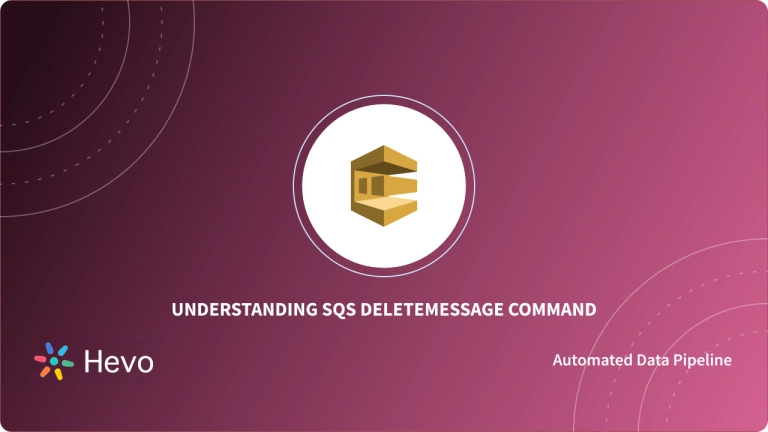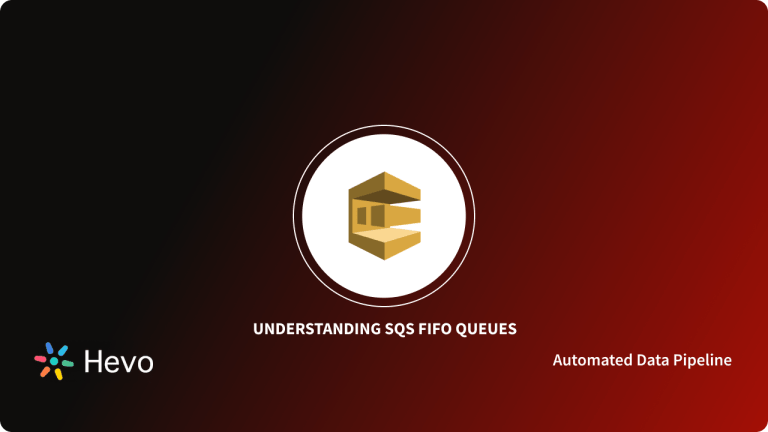Modern developers create complex applications that require a communication setup for exchanging messages among their components. Moreover, even a slight change in the message sequence can render the application useless in certain instances. Therefore, developers seek automated services that can share their load of managing this message-based communication. Amazon SQS is one such message management solution.
Amazon Simple Queue Service (SQS) is a robust and high-performance driven solution that offers queues to support message transactions between applications or among the components of an application. This tool automates the communication aspect of software development and allows developers to focus on their programming tasks.
This article introduces you to Amazon SQS and explains its key features. It will further discuss its importance and explain the difference between Amazon SNS, MQ and SQS. The article will also list down the steps required to set up your AWS SQS Queues and elaborate on the working of its architecture. Read along to understand the working, benefits and limitations of Amazon SQS!
Hevo, an enterprise-grade data pipeline as a service, enables real-time data transfer from various sources to any destination without requiring any coding. Designed to handle large-scale data, Hevo ensures that your data is transferred reliably, accurately, and consistently.
Table of Contents
Key Features of Hevo:
- Fully Managed: Hevo is a fully automated platform, eliminating the need for management and maintenance.
- Easy to Use: With its simple and interactive UI, Hevo is user-friendly, making it easy for new customers to perform operations.
- Schema Management: Hevo automatically detects the schema of incoming data and maps it to the destination schema.
Simplify your data warehousing and analysis with Hevo today!
Get Started with Hevo for FreeWhat is AWS SQS?
Amazon SQS (Simple Queue Service) is a fully managed service popular for its message queuing functionality. Developers often send and retrieve messages of various types and sizes asynchronously using this service. Amazon SQS empowers you to keep individual microservices and distributed systems separate from each other. Moreover, it lets you scale these systems and automates the process of establishing and maintaining the message queues.
Amazon SQS provides a safe passage to establish communication between software components. Moreover, Amazon SQS deploys a program interface that allows you to access and use various web services through popular programming languages. Amazon SQS offers its facilities for tasks that operate asynchronously. This implies that Amazon SQS simplifies the work of an application that can now simply send messages to a queue instead of directly trying to invoke another application individually. This way, multiple applications can easily view that message, and your program can work with reduced time complexity.
Key Features of AWS SQS
The following features make AWS SQS a popular message management solution among developers:
- Durability: Amazon SQS relies on multiple servers to store your messages safely. Moreover, its Standard Queues & FIFO Queues operate on an at-least-once & exactly-once message delivery system.
- Availability: Amazon SQS leverages redundant infrastructure to generate high speed concurrent messaging. This way, it ensures that you experience an increased availability of messages for both production and consumption.
- Scalability: Amazon SQS offers you high scalability as it can independently process all the buffered message requests. Furthermore, it can scale transparently in sudden load spikes and does not need any prior instructions.
- Reliability: Amazon SQS uses a message locking mechanism during the processing phase. This allows multiple producers to send messages simultaneously to various consumers.
Importance of AWS SQS
Developers face huge issues while creating message management software. Building such complex software demands vast experience and skilled professionals. There are specific alternative options available in the market, but they usually require upfront development. Moreover, such alternatives also need regular hardware maintenance and human resource for managing system administration. Amazon SQS offers you a simpler path to achieve message management between applications without going through the development and configuration hassle. Furthermore, it does not require any additional time or resources to manage your message queues.
Amazon SQS has the capability to decouple an application into components and run them independently. This way, in case of a component failure, other components will still function without suffering any blow. This way, Amazon SQS provides very high stability and fault tolerance. Moreover, you can easily control who will send and receive messages from your Amazon SQS Queues. It also uses the Server Side Encryption (SSE) algorithm to transmit your sensitive data safely.
AWS SQS vs MQ vs SNS: Key Differences
Amazon MQ is a fully managed service that connects you with popular message brokers. This tool is helpful if you need to migrate applications from your existing message brokers. Moreover, it is readily compatible with APIs like JMS or various protocols, including AMQP, OpenWire, etc.
Amazon SQS is well known for its serverless queues, which provide you fast and robust messaging facility without requiring you to pay for infrastructure.
Amazon SNS operates in the domain of serverless topics. Its notification facility keeps you up to date with new message arrivals, but only if you are online. Moreover, SNS is capable of integrating with Amazon SQS. This implies that if you have a fluctuating service, you can ensure it gets SNS messages by queueing the service’s schedule.
Moreover, Amazon SQS and Amazon SNS are queue-based services that offer high scalability and ease of use and don’t require you to integrate with message brokers.
Basic Architecture & Queues in AWS SQS
The AWS SQS architecture consists of 3 key parts that form a distributed messaging system. These 3 parts, Components, Queue, and the Messages present in the Queue, collaborate to provide you with a message management system.
The below image shows all of the 3 components at work in an instance of AWS SQS. In the image’s system, several producers ( type of components that are responsible to send messages) input messages into the queue. Moreover, several consumers (type of components that are responsible to receive the output messages from the queue) are waiting for their messages. The 3rd component is the Queue which contains messages A to E) and stores them using multiple Amazon servers.
Now, the Amazon SQS Queues can be of 2 types:
Standard Queues
Amazon SQS provides Standard Queues as the default option which enables you to work with nearly an unlimited amount of API calls every second per API action. These actions include SendMessage, ReceiveMessage, or DeleteMessage. Moreover, Standard queues operate on the “at-least-once” message model for delivery. Standard Queues also emphasise the correct ordering of your messages and deliver the message in the original order by default.
Fifo Queue
FIFO (First-In-First-Out) queues are built with the objective to enhance inter-application messaging in cases where the sequence of operations is crucial or where redundancy is not permissible. For instance, you may implement FIFO Queues in the following situations:
- Using FIFO Queues to ensure that the application is running the right order of user-entered commands.
- Using FIFO Queues to display the accurate product price by transmitting the price modifications in the correct sequence.
- Using FIFO Queues to ensure that a student should not enrol in a course without submitting the fee.
Steps to Set up AWS SQS
You can leverage the Amazon SQS console to build Standard and FIFO Queues. The console also offers default values for various settings. You can follow the below steps to set up your own AWS SQS Queue:
- Open the Amazon SQS console at https://console.aws.amazon.com/sqs/ and click on Create queue.
- In the Type option, the default setting is for the Standard queue. To change it to the FIFO queue, click on FIFO.
- Enter a suitable queue name and ensure that if it is a FIFO queue, its name have to end with the suffix .fifo. Keep in mind that you can not change the Queue name once it is created.
- Select the Visibility Timeout option and input a suitable duration with units. (The range allowed is from 0 seconds to 12 hours.) Moreover, for the Message retention period option, enter the required duration ranging from 1 minute to 14 days.
- Next, set the Delivery delay between 0 seconds to 15 minutes and set the Maximum message size between 1 KB to 256 KB. Moreover, to use a FIFO queue, select Enable content-based deduplication.
- To set the Redrive to allow policy, select one from the Allow all, By queue and Deny all options. Finally, click on Create queue.
The Amazon SQS console will create the required queue and display its details page.
Now, you can navigate to the Queues option on the left side and from this option, choose the queue that you created using the above steps. You can then type your message in it and the receiver’s id and click on send as shown in the below image.
Pricing & Compliance of AWS SQS
A major reason for Amazon SQS’s popularity is the absence of upfront cost to use its services. Moreover, you do not have to pay a penny for its maintenance or buy any supporting tools. Amazon SQS’s cost model is based on the concept of pay as you use. This implies that you can save a substantial amount of money by not relying on some other alternative solution that works on a high pricing model. Furthermore, using AWS Free Tier, you can generate up to 1 million requests in Amazon SQS per month for free.
You can learn more about Amazon SQS pricing, here.
AWS SQS is highly compatible, especially with other Amazon tools. The following list contains some of the most popular integrations for Amazon SQS:
- Amazon Relational Database Service
- Amazon Elastic Compute Cloud
- Amazon Simple Storage Service.
Limitations of AWS SQS
The previous sections discussed the importance and benefits of using AWS SQS. However, this tool also contains the following limitations:
- During development, you may need to fine-tune the message management system with respect to a scale to optimise its output. However, Amazon SQS does not provide such an option. Since the messaging service is automated, you are not able to change or edit anything.
- The pay as you use model can cost you more money if the messages you are sending are massive. This is because data transfer costs are part of the SQS fees, and large messages will lead to a much higher overall pricing.
- Amazon SQS is not capable of supporting multiple organisations to access the same message as it operates on an “exactly once” transmission model. However, you can work around this limitation by integrating Amazon SQS with SNS for situations involving one-to-many deliveries.
Get insights into AWS SQS pricing models for optimal budgeting. Learn more at SQS Pricing Details.
Conclusion
This article introduced you to Amazon SQS and discussed its key features. It also explained the importance and architecture of this message management system. The article further discussed the steps required to set up your AWS SQS and also explained the difference between Amazon SNS, MQ and SQS. Furthermore, the article explained certain limitations associated with using the AWS SQS Queues.
Improve your message handling in AWS SQS by understanding how to use the DeleteMessage action effectively. Discover key insights at SQS DeleteMessage.
Amazon SQS is great for managing your messages and providing data to your program in the correct order. However, at times, you need to transfer this data from multiple sources to your Data Warehouse for analysis. Building an in-house solution for this process could be an expensive and time-consuming task. Hevo Data, on the other hand, offers a No-code Data Pipeline that can automate your data transfer process, hence allowing you to focus on other aspects of your business like Analytics, Customer Management, etc. This platform allows you to transfer data from 150+ sources to Cloud-based Data Warehouses like Snowflake, Google BigQuery, Amazon Redshift, etc. It will provide a hassle-free experience and make your work life much easier.
Want to take Hevo for a spin? Sign Up for a 14-day free trial and experience the feature-rich Hevo suite firsthand.
Share your views on Amazon SQS in the comments section!
FAQs
1. What are the limitations of using SQS?
SQS has a message size limit of 256 KB. FIFO queues support up to 300 transactions per second (3,000 with batching), and messages can be retained for up to 14 days. There are also visibility timeout and dead-letter queue limits.
2. How many messages can SQS handle per second?
Standard queues can handle an unlimited number of messages per second. FIFO queues handle up to 300 messages per second (3,000 with batching).
3. How long can you keep your Amazon SQS messages in Amazon SQS queues?
Messages can be retained in SQS queues for a minimum of 1 minute and a maximum of 14 days.





